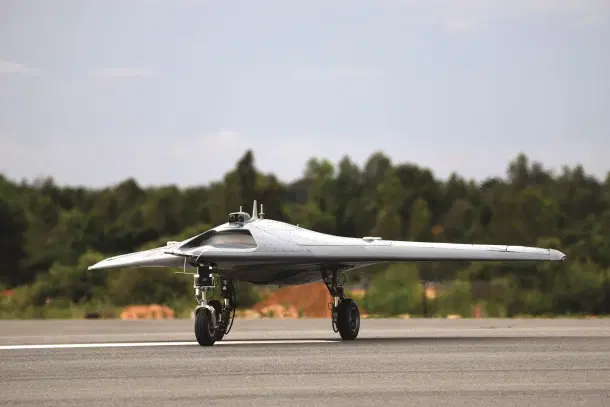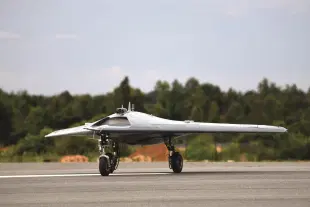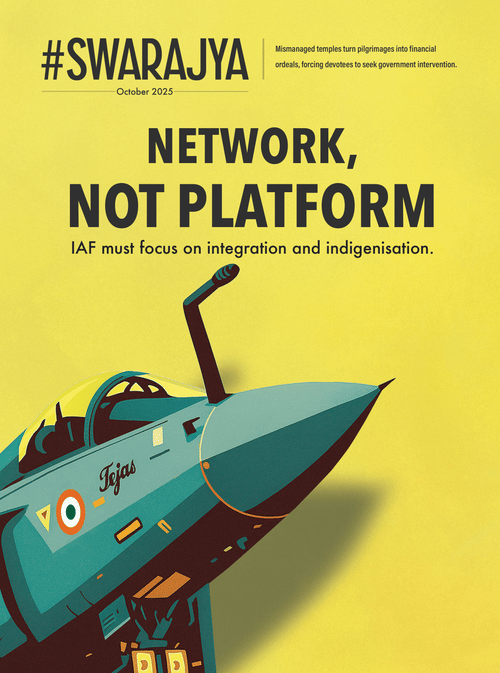Defence
India Needs Asymmetric Weapons To Fight China. The Time To Fund Them Is Now
Prakhar Gupta
Oct 14, 2025, 11:44 AM | Updated 11:44 AM IST
Save & read from anywhere!
Bookmark stories for easy access on any device or the Swarajya app.


When Chinese troops rolled their Type 15 light tanks up to the Line of Actual Control in 2020, India was caught without an equivalent platform. The sudden imbalance spurred a rare burst of urgency. Within months, the Defence Research and Development Organisation and Larsen & Toubro were tasked with developing a light tank tailored for the high-altitude terrain of Ladakh. The result, Zorawar, was designed, built and readied for testing in just over a year and a half.
That pace is almost unheard of in Indian defence manufacturing. It was possible because of focused funding, close coordination between a state enterprise and a private manufacturer, and political will that treated the project as a wartime necessity. When a need is clear and immediate, India can move quickly.
But when it comes to the technologies that could give India asymmetric advantages against a far larger adversary, that same urgency disappears.
The Zorawar is a story of what India can do when it decides to act. The story of India’s asymmetric capabilities is one of hesitation.
Asymmetric warfare is the art of using the other side’s strengths against it. It is not about matching tank for tank or jet for jet. It is about finding ways to fight differently, using technology and surprise to inflict costs that far exceed the expense of the weapon. For a country like India, whose main challenge is China, such tools are not luxuries. They are necessities. China’s economy, industrial base and defence budget are much larger. India cannot compete symmetrically. What it can do is compete intelligently, with systems that strike from unexpected directions and make any act of aggression too costly to risk.
That logic has been clear for years. Yet progress on India’s asymmetric capabilities has been slow. Four programmes in particular show the problem: the Ghatak stealth drone, the HAL Combat Air Teaming System, the Supersonic Missile Assisted Release of Torpedo known as SMART, and work on non-kinetic counter-space technologies.
Each of these could shift India’s deterrence equation. But each of them is stuck at a stage where little or no funding has been committed.
The Ghatak is meant to be India’s first stealth unmanned combat aerial vehicle, a flying wing designed for deep strikes. Its scaled-down demonstrator, called the Stealth Wing Flying Testbed or Swift, has already flown successfully. The concept is proven. But the full-scale Ghatak remains without proper funding.
Ghatak is not an archetypal asymmetric weapon like cheap kamikaze drones; it is a high-end, stealthy UCAV whose value lies in precision, reach and survivability rather than attritability. Yet a handful of well timed Ghatak strikes against forward C2 nodes, air-defence radars or logistics hubs would force an opponent to disperse, harden and divert expensive sensors and interceptors, imposing costs far larger than the platforms themselves.
When used as the tip of a mixed toolkit, seeding confusion with swarms of attritable loitering munitions, masking approaches with electronic warfare and cueing strikes with passive sensors, Ghatak becomes an asymmetric enabler. It does not win by numbers, it wins by creating dilemmas and multiplying the opponent’s defensive burden.
But for years the project has lived off incremental allocations and laboratory work. A stealth drone that could project power across the Himalayas without risking a pilot remains just another project moving at a glacial pace. China already operates stealth drones such as the GJ-11 Sharp Sword, while India is still waiting for the first prototype of Ghatak.
The Combat Air Teaming System being developed by Hindustan Aeronautics Limited is another example. The concept is for a manned fighter, likely a two-seat Tejas, to control a formation of loyal wingman drones that can scout, jam or strike ahead of it. HAL, DRDO and private firms such as NewSpace Research have been working on the idea for several years. Early design work and some funding have been approved. Models have been displayed at air shows. But there is still no working prototype.
China, meanwhile, has already developed multiple manned and unmanned teaming systems, signalling a rapid evolution in how the PLA Air Force envisions future air combat. At the centre of this push is the Feihong FH-97A, a loyal wingman drone developed by CASC that mirrors the U.S. Kratos XQ-58A in design and concept, capable of reconnaissance, electronic warfare and strike missions alongside piloted aircraft.
The stealthy GJ-11 Sharp Sword is believed to have reached near-operational maturity and has been spotted at forward bases such as Shigatse in Tibet, just north of Sikkim, suggesting active field trials. AVIC’s Sky Hawk and LJ-1 drones have also been shown performing simulated swarm and escort roles with J-16 and J-20 fighters. Analysts expect the two-seat J-20S variant to serve as a controller platform for such unmanned assets, using advanced datalinks to coordinate multiple drones in real time. Although these systems remain at varying stages of testing, their level of maturity is already far ahead of where India’s own manned–unmanned teaming concepts currently stand.
The SMART system for the Indian Navy is yet another example. It combines a supersonic missile and a lightweight torpedo to create a long-range anti-submarine weapon.
In 2024 DRDO successfully tested the weapon. The missile carried the torpedo hundreds of kilometres, released it by parachute, and allowed it to home in on a simulated target. It is a concept that could give India a powerful sea-denial weapon. But so far it remains a demonstration. To become operational, it needs more testing, integration with naval systems and the funding to move into production. That funding has not been announced.
The fourth, and perhaps the most critical, area is space. Here the contrast with China is the most striking. Beijing has invested heavily in counter-space capabilities such as lasers that can dazzle or damage satellites, jammers that can block communications, and small satellites that can approach or interfere with others in orbit.
India, by contrast, still relies mainly on a single, demonstrative capability, the 2019 Mission Shakti anti-satellite missile test, which destroyed a low-orbit target. It proved that India could kinetically take down a satellite, but such weapons are crude and escalatory, creating debris and offering no flexibility for limited or reversible effects.
China’s focus has shifted towards non-kinetic options like directed-energy systems, co-orbital interference satellites, and electronic jamming that can disable or degrade space assets without crossing the threshold of overt attack. ISRO’s later experiments, such as the SpaDeX docking mission in 2024, remain scientific rather than military.
In any conflict where China sought to blind India’s satellites or jam its navigation systems, India would have few ways to respond in kind.
Space has become the new high ground, and India is climbing too slowly. China has invested in a robust, multi-layered PNT backup architecture to reduce its dependence on satellite systems and improve resilience. Its completed national eLoran network, long-wave terrestrial radio timing stations, now operates alongside fibre-optic timing links and the BeiDou navigation system, forming a terrestrial complement to satellite PNT.
By contrast, India’s own regional navigation system, NavIC, has struggled with recurring failures of onboard atomic clocks, forcing the replacement of multiple satellites and degrading the system’s accuracy and reliability. Despite recent upgrades and plans to expand global coverage, NavIC remains vulnerable: it lacks both the redundancy of terrestrial timing networks and the hardened architecture needed to resist jamming or spoofing. Without a comparable ground-based backup or fibre-linked timing infrastructure, India’s navigation network would be among the first casualties in a space-denied environment.
The pattern is familiar. Projects are funded just enough to survive in labs, never enough to mature. Bureaucratic procedures delay clearances and approvals for years. The focus remains on visible, conventional systems such as tanks for the mountains, rifles for the infantry and fighters for the Air Force. All of these are necessary. None of them will fundamentally alter the strategic balance with China. Asymmetric capabilities could.
Each of these technologies, if developed properly, would give India a different kind of deterrent. A stealth drone like Ghatak could hit command centres or radar networks deep behind the front line. A manned–unmanned team like CATS could overwhelm enemy air defences with swarming drones.
SMART would extend India’s anti-submarine reach far beyond its coastal waters. Counter-space systems could degrade Chinese reconnaissance and communications, which are essential for coordinating operations across the mountains. These are not theoretical advantages. They are practical, proven concepts already used in modern conflicts. Drones in Ukraine and the Middle East have shown how small, inexpensive platforms can achieve strategic results.
The question is not whether India can develop such weapons. The prototypes and testbeds prove that it can. The question is whether the country is willing to fund them at the scale needed. The Zorawar tank demonstrates what can happen when there is no choice. The same urgency must be applied to these new capabilities before a crisis forces it.
The broader challenge is institutional. India’s defence ecosystem still runs on the logic of state-led development with limited room for private initiative. That has been changing but not at the speed and scale that is needed. The partnership between DRDO and L&T that produced the Zorawar should not be an exception. It should be the rule.
HAL, DRDO and ISRO will remain central to high-end R&D, but they cannot carry the load alone. Startups and private firms are already experimenting with drones, electronic warfare and space systems. They need clear procurement pathways and assured demand to scale up. The idea of self-reliance will remain hollow unless the system rewards speed and innovation.
The danger is not that India will fail to build these capabilities. It is that it will build them too late. China is already fielding hypersonic gliders, laser weapons and robotic swarms. India is still deciding whether to fund its first stealth drone. Deterrence depends not only on having the technology, but on being seen to have it. The existence of credible asymmetric systems complicates an adversary’s planning long before a conflict begins.
India has already shown that it can move fast when it must. It did so with the Zorawar because it saw an immediate threat. The same clarity of purpose is needed for technologies that will define the next decade of warfare. A stealth drone, a missile that carries a torpedo across oceans, or a space-based jammer may sound abstract compared to a tank on a mountain road. Yet those are the tools that could decide how a future confrontation unfolds. The time to fund and build them is now, not after the crisis begins.
Prakhar Gupta is a senior editor at Swarajya. He tweets @prakharkgupta.





